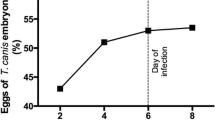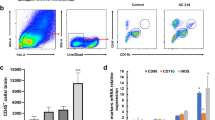Abstract
Infective larvae of Toxocara canis and T. cati, the common roundworms of dogs and cats, may invade the central nervous system of paratenic hosts, including humans, causing neurotoxocarosis (NT). Previous studies on NT in the model organism “mouse” have indicated distinct differences between T. canis and T. cati regarding larval migration patterns as well as the severity of clinical symptoms and behavioural alterations. The objective of the present study was to provide an extensive characterization of the underlying histopathological alterations, comparing T. canis- and T. cati-induced changes in different brain areas over the course of murine infection. Four histological sections of five brains each of T. canis- and T. cati-infected as well as uninfected C57Bl/6 mice were investigated 7, 14, 28, 42, 70 and 98 days post infection (dpi), while brains of T. cati-infected and control mice were also available 120 and 150 dpi. In addition to haematoxylin-eosin and luxol fast blue-cresyl violet staining, immunohistochemistry was employed to study microglia/macrophage cell morphology and to detect accumulation of β-amyloid precursor protein (β-APP) as an indicator of axonal damage. Haemorrhages, eosinophilic vasculitis and activated microglia/macrophages were detected in both infection groups starting 7 dpi, followed by eosinophilic meningitis in cerebra as from 14 dpi. Overall, little differences in the proportion of animals affected by these alterations were found between the two infection groups. In contrast, the proportion of animals displaying β-APP accumulation was significantly higher in the T. canis than T. cati group as from 28 dpi regarding the cerebrum as well as at 98 dpi regarding the cerebellum. In T. canis-infected mice, myelinophagic microglia/macrophages (“gitter cells”) appeared as from 14 dpi, whereas these were first observed at 70 dpi in T. cati-infected animals. The proportion of animals displaying demyelination and/or gitter cells in the cerebrum was significantly higher in the T. canis than T. cati group as from 28 dpi, and at 28 and 42 dpi regarding the cerebellum. Earlier and more severe neurodegeneration during T. canis- than T. cati-induced NT, especially in the cerebrum, may explain the differences in behavioural alterations observed in previous studies. In addition to differences in larval migration preferences, immunological processes may contribute to these patterns, which warrant further investigation.



Similar content being viewed by others
Abbreviations
- ABC:
-
avidin-biotin-peroxidase
- BSA:
-
bovine serum albumin
- β-APP:
-
β-amyloid precursor protein
- dpi:
-
day post infection
- H&E:
-
haematoxylin-eosin
- LFB:
-
luxol fast blue-cresyl violet
- PBS:
-
phosphate-buffered saline
- pi:
-
post infection
- NT:
-
neurotoxocarosis
References
Aggleton JP, Keith AB, Rawlins JNP, Hunt PR, Sahgal A (1992) Removal of the hippocampus and transection of the fornix produce comparable deficits on delayed non-matching to position by rats. Behav Brain Res 52:61–71
Buckley MJ, Charles DP, Browning PGF, Gaffan D (2004) Learning and retrieval of concurrently presented spatial discrimination tasks: role of the fornix. Behav Neurosci 118:138–149
Boche D, Perry VH, Nicoll JAR (2013) Review: activation patterns of microglia and their identification in the human brain. Neuropathol Appl Neurobiol 39:3–18
Dolinsky ZS, Hardy CA, Burright RG, Donovick PJ (1985) The progression of behavioral and pathological effects of the parasite Toxocara canis in the mouse. Physiol Behav 35:33–42
Eid MM, El-Kowrany SI, Othman AA, Gendy DIE, Saied EM (2015) Immunopathological changes in the brain of immunosuppressed mice experimentally infected with Toxocara canis. Korean J Parasitol 53:51–58
Epe C, Sabel T, Schnieder T, Stoye M (1994) The behavior and pathogenicity of Toxacara canis larvae in mice of different strains. Parasitol Res 80:691–695
Erickson LD, Gale SD, Berrett A, Brown BL, Hedges DW (2015) Association between toxocariasis and cognitive function in young to middle-aged adults. Folia Parasitol 62:048
Fan C-K, Holland CV, Loxton K, Barghouth U (2015) Cerebral toxocariasis: silent progression to neurodegenerative disorders? Clin Microbiol Rev 28:663–686
Fukae J, Kawanabe T, Akao N, Kado M, Tokoro M, Yokoyama K, Hattori N (2012) Longitudinal myelitis caused by visceral larva migrans associated with Toxocara cati infection: case report. Clin Neurol Neurosurg 114:1091–1094
Graeff-Teixeira C, da Silva ACA, Yoshimura K (2009) Update on eosinophilic meningoencephalitis and its clinical relevance. Clin Microbiol Rev 22:322–348
Gregersen R, Christensen T, Lehrmann E, Diemer NH, Finsen B (2001) Focal cerebral ischemia induces increased myelin basic protein and growth-associated protein-43 gene transcription in peri-infarct areas in the rat brain. Exp Brain Res 138:384–392
Hamilton CM, Stafford P, Pinelli E, Holland CV (2006) A murine model for cerebral toxocariasis: characterization of host susceptibility and behaviour. Parasitology 132:791–801
Heuer L, Beyerbach M, Lühder F, Beineke A, Strube C (2015) Neurotoxocarosis alters myelin protein gene transcription and expression. Parasitol Res 114:2175–2186
Holland C (2015) Knowledge gaps in the epidemiology of Toxocara: the enigma remains. Parasitology 144:81–94
Holland C, Cox D (2001) Toxocara in the mouse: a model for parasite-altered host behaviour? J Helminthol 75:125
Janecek E, Beineke A, Schnieder T, Strube C (2014) Neurotoxocarosis: marked preference of Toxocara canis for the cerebrum and T. cati for the cerebellum in the paratenic model host mouse. Parasit. Vectors 7:1–13
Janecek E, Waindok P, Bankstahl M, Strube C (2017) Abnormal neurobehaviour and impaired memory function as a consequence of Toxocara canis- as well as Toxocara cati-induced neurotoxocarosis. PLoS Negl Trop Dis 11:e0005594
Janecek E, Wilk E, Schughart K, Geffers R, Strube C (2015) Microarray gene expression analysis reveals major differences between Toxocara canis and Toxocara cati neurotoxocarosis and involvement of T. canis in lipid biosynthetic processes. Int J Parasitol 45:495–503
Kazek B, Jamroz E, Mandera M, Bierzyńska-Macyszyn G, Kluczewska E, Marszał E (2006) The cerebral form of toxocarosis in a seven-year-old patient. Folia Neuropathol 44:72–76
Liao C-W, Fan C-K, Kao T-C, Ji D-D, Su K-E, Lin Y-H, Cho W-L (2008) Brain injury-associated biomarkers of TGF-beta1, S100B, GFAP, NF-L, tTG, AbetaPP, and tau were concomitantly enhanced and the UPS was impaired during acute brain injury caused by Toxocara canis in mice. BMC Infect Dis 8:84
Lull ME, Block ML (2010) Microglial activation and chronic neurodegeneration. Neurotherapeutics 7:354–365
Magnaval JF, Michault A, Calon N, Charlet JP (1994) Epidemiology of human toxocariasis in La Reunion. Trans R Soc Trop Med Hyg 88:531–533
Moiyadi A, Mahadevan A, Anandh B, Shivashankar RS, Chickabasavaiah YT, Shankar SK (2007) Visceral larva migrans presenting as multiple intracranial and intraspinal abscesses. Neuropathology 27:371–374
Otero D, Alho AM, Nijsse R, Roelfsema J, Overgaauw P, Madeira de Carvalho L (2018) Environmental contamination with Toxocara spp. eggs in public parks and playground sandpits of Greater Lisbon, Portugal. J Infect Public Health 11:94–98
Othman AA, Abdel-Aleem GA, Saied EM, Mayah WW, Elatrash AM (2010) Biochemical and immunopathological changes in experimental neurotoxocariasis. Mol Biochem Parasitol 172:1–8
Park SA, Hahn JH, Kim JI, Na DL, Huh K (2000) Memory deficits after bilateral anterior fornix infarction. Neurology 54:1379–1382
R Core Team (2018) R: a language and environment for statistical computing. Vienna, Austria, R Foundation for Statistical Computing
Sánchez SS, García HH, Nicoletti A (2018) Clinical and magnetic resonance imaging findings of neurotoxocariasis. Front Neurol 9:53
Scheid R, Tina Jentzsch R, Schroeter ML (2008) Cognitive dysfunction, urinary retention, and a lesion in the thalamus—beware of possible toxocariasis of the central nervous system. Clin Neurol Neurosurg 110:1054–1057
Shimizu T (1993) Prevalence of Toxocara eggs in sandpits in Tokushima city and its outskirts. J Vet Med Sci 55:807–811
Stensvold CR, Skov J, Moller LN, Jensen PM, Kapel CM, Petersen E, Nielsen HV (2009) Seroprevalence of human toxocariasis in Denmark. Clin Vaccine Immunol 16:1372–1373
Strube C, Heuer L, Janecek E (2013) Toxocara spp. infections in paratenic hosts. Vet Parasitol 193:375–389
Subramaniam SR, Federoff HJ (2017) Targeting microglial activation states as a therapeutic avenue in Parkinson’s disease. Front Aging Neurosci 9:176
Summers B, Cypess RH, Dolinsky ZS, Burright RG, Donovick PJ (1983) Neuropathological studies of experimental toxocariasis in lead exposed mice. Brain Res Bull 10:547–550
Takamoto M, Ovington KS, Behm CA, Sugane K, Young IG, Matthaei KI (1997) Eosinophilia, parasite burden and lung damage in Toxocara canis infection in C57Bl/6 mice genetically deficient in IL-5. Immunology 90:511–517
Tsivilis D, Vann SD, Denby C, Roberts N, Mayes AR, Montaldi D, Aggleton JP (2008) A disproportionate role for the fornix and mammillary bodies in recall versus recognition memory. Nat Neurosci 11:834–842
Vann SD, Denby C, Love S, Montaldi D, Renowden S, Coakham HB (2008) Memory loss resulting from fornix and septal damage: impaired supra-span recall but preserved recognition over a 24-hour delay. Neuropsychology 22:658–668
Waindok P, Strube C (2019) Neuroinvasion of Toxocara canis- and T. cati -larvae mediates dynamic changes in brain cytokine and chemokine profile. J Neuroinflammation 16:147
Walsh MG, Haseeb MA (2012) Reduced cognitive function in children with toxocariasis in a nationally representative sample of the United States. Int J Parasitol 42:1159–1163
Acknowledgements
The authors wish to thank Fred Lühder for valuable comments on the manuscript and Solveig Blumenbecker and Sabine Händel for excellent technical assistance.
Author information
Authors and Affiliations
Corresponding author
Ethics declarations
Conflict of interest
The authors declare that they have no conflict of interest.
Additional information
Section Editor: Domenico Otranto
Publisher’s note
Springer Nature remains neutral with regard to jurisdictional claims in published maps and institutional affiliations.
Rights and permissions
About this article
Cite this article
Springer, A., Heuer, L., Janecek-Erfurth, E. et al. Histopathological characterization of Toxocara canis- and T. cati-induced neurotoxocarosis in the mouse model. Parasitol Res 118, 2591–2600 (2019). https://doi.org/10.1007/s00436-019-06395-7
Received:
Accepted:
Published:
Issue Date:
DOI: https://doi.org/10.1007/s00436-019-06395-7




